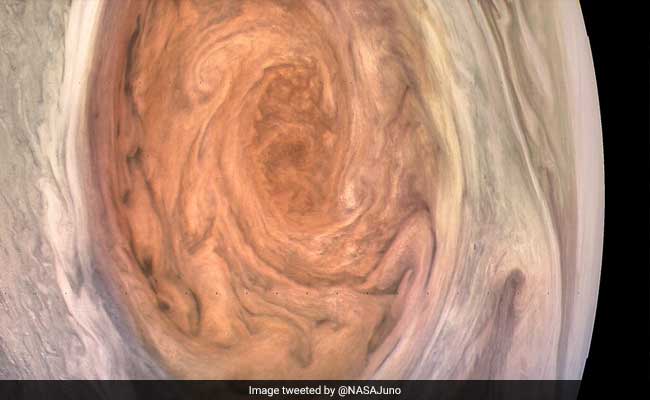
The image of Jupiter is not a painting - it's a mosaic made from real data taken by Voyager spacecraft.
- NASA sent its Juno spacecraft skimming above the Great Red Spot
- The spacecraft was just 2,200 miles above the spot's roiling cloud tops
- Juno is the only human-built object to have come this close to the Spot
Did our AI summary help?
Let us know.
Imagine a storm so vast it could swallow the Earth and so powerful that it has swirled nonstop for 350 years. That is Jupiter's Great Red Spot.
On Monday, NASA sent its Juno spacecraft skimming just 2,200 miles above the spot's roiling cloud tops. It was the closest any human-built object has come to the biggest storm in our solar system.
The plucky probe made it through without a scratch. Now, data and stunning images are streaming back to NASA, where scientists are processing the information as quickly as they can. It will take weeks, even months, for the science data to come out, and scientists will likely study this flyby for years to come.

The Great Red Spot has more than just good looks going for it. The massive weather system - its composition and internal dynamics are still something of a mystery - could help scientists understand weather on Earth and on worlds beyond our solar system.
"If you just look at reflected light from an extrasolar planet, you're not going to be able to tell what it's made of," Amy Simon, an expert in planetary atmospheres at the Goddard Space Flight Center, said in a NASA news release. "Looking at as many possible different cases in our own solar system could enable us to then apply that knowledge to extrasolar planets."

(This story has not been edited by NDTV staff and is auto-generated from a syndicated feed.)
On Monday, NASA sent its Juno spacecraft skimming just 2,200 miles above the spot's roiling cloud tops. It was the closest any human-built object has come to the biggest storm in our solar system.
The plucky probe made it through without a scratch. Now, data and stunning images are streaming back to NASA, where scientists are processing the information as quickly as they can. It will take weeks, even months, for the science data to come out, and scientists will likely study this flyby for years to come.

The Great Red Spot has more than just good looks going for it. The massive weather system - its composition and internal dynamics are still something of a mystery - could help scientists understand weather on Earth and on worlds beyond our solar system.
"If you just look at reflected light from an extrasolar planet, you're not going to be able to tell what it's made of," Amy Simon, an expert in planetary atmospheres at the Goddard Space Flight Center, said in a NASA news release. "Looking at as many possible different cases in our own solar system could enable us to then apply that knowledge to extrasolar planets."

(This story has not been edited by NDTV staff and is auto-generated from a syndicated feed.)
Track Latest News Live on NDTV.com and get news updates from India and around the world

